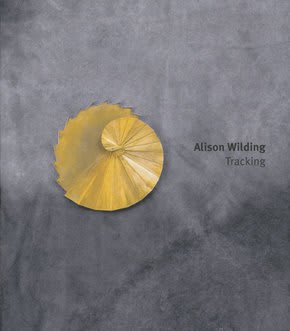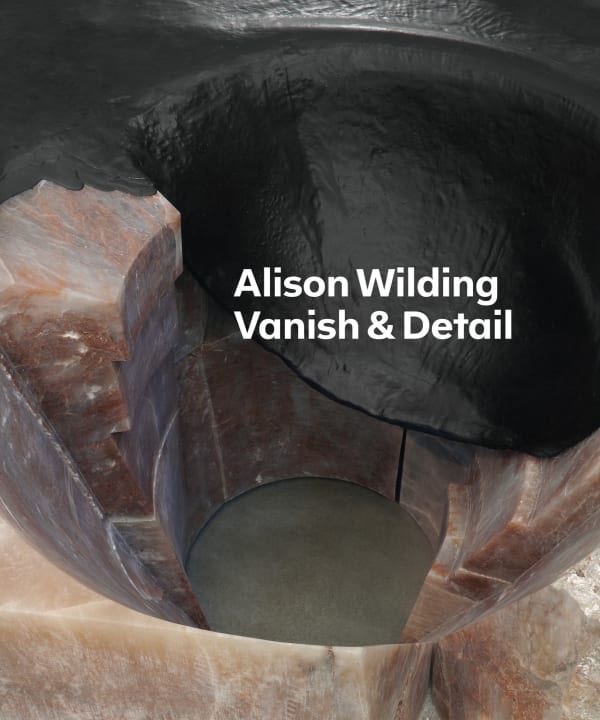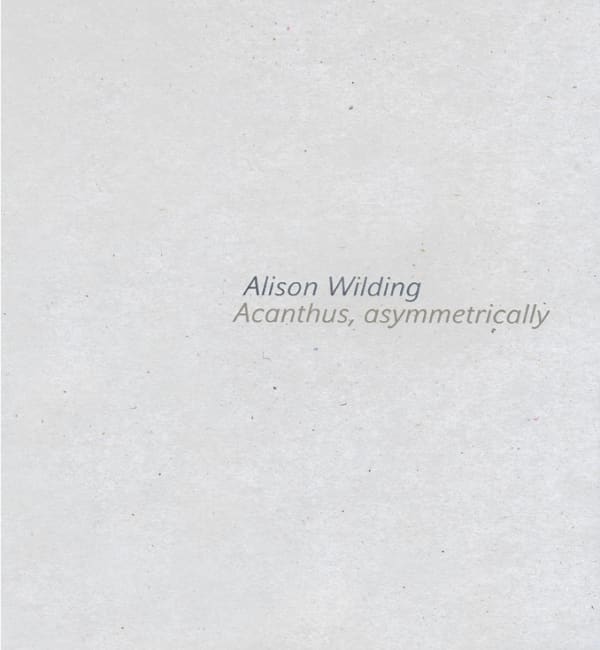Alison Wilding
One of Britain's foremost sculptors, Alison Wilding’s work explores inherent contrasts through her innovative approach to material.
Alison Wilding has challenged expectations of sculpture since the 1970s. Her innovative practice combines a wide variety of materials, techniques and forms to create sculptures that examine contrasts, whether it be juxtapositions of containment and concealment, stability and instability, entrapment and mobility, or the disparity between the viewer’s assumption of a material and the artist’s manipulation of it.
Born in 1948 in Blackburn, Wilding studied at Nottingham College of Art from 1966 to 1967. She continued her education at Ravensbourne College of Art, London, between 1967 and 1970, after which she studied at the Royal College of Art, specialising in sculpture. Wilding rose to prominence in the 1980s as part of the New British Sculpture, a group that also included Richard Deacon, Tony Cragg and Anish Kapoor and was known for combining traditional and new industrial materials with both figurative and abstract imagery.
Wilding has relentlessly developed her practice over the course of her career. Since her early sculptural works she has consistently explored the parameters of the medium, from what constitutes sculpture to how it may be experienced. An enduring facet of her art is the manipulation of materials. Wilding rejects any traditional hierarchy of materials, whether industrial or organic, reclaimed or repurposed, and her selection frequently arises from what is available to her at any one time. A rope, a slab of stone, cast acrylic sheets or some reclaimed wood might form the starting point for a work, which develops through a process of problem-solving and negotiating with her chosen materials. Employed in eclectic combinations, they are transformed into sensual constructions of texture, colour, mass and shape.
Distinctions and disparities such as containment and concealment, darkness and light, visibility and invisibility are intrinsic to Wilding’s practice. In many of the sculptures, an object is confined within or beneath the larger structure of the work, partially concealed from the viewer and marking a border between interior and exterior. Other works explore duality by exposing the external and internal at the same time, as in her monocoque sculptures. Exploring balance, gravity and equilibrium, the monocoques are created by interlacing individual slats of wood or metal so as to become self-supporting. Here, individual elements appear to slot together solidly yet also seem in a state of mobility, as if their ability to remain stable is at the mercy of the viewer. Whether at a hand-held scale or larger than life-sized, all retain a suggestion of the monumental and therefore play on the viewer’s expectation, creating intimate and surprising encounters.
Although best known as a sculptor, drawing has increasingly become an important element of Wilding’s practice. Though the drawings—which are predominantly abstract, though several make reference to figurative forms—comprise a distinct aspect of her work, they bear similarities to the sculptures in how form, space and colour are employed.
Wilding is fascinated by the wider environmental setting of sculpture and with exploring how her objects might fit into the world. The relationship between the work and the audience is essential: her works repel the casual glance, instead requiring the viewer to engage intensely with them. Through their inherent physical expressiveness, the sculptures call on the viewer to observe, move around and take in the work from numerous angles, so that subject and object become entangled in a dynamic, tense relationship.
Wilding lives and works in London. She has taught at Brighton Polytechnic, Middlesex Polytechnic, Royal College of Art and Slade School of Fine Art. In 2018 she was appointed Eranda Professor of Drawing at the Royal Academy Schools. Her work is held in public collections including Tate, London; Musée des Beaux Arts, Calais; Victoria and Albert Museum, London; Art Gallery of New South Wales, Sydney; Scottish National Gallery of Modern Art, Edinburgh; British Museum, London; and Fonds régional d’art contemporain (Frac), Pays de la Loire.
Solo exhibitions by Wilding include De La Warr Pavilion, Bexhill-on-Sea (2018); Whitworth Art Gallery, Manchester (2013, 2018); Duveen Galleries, Tate Britain, London (2013); Museum of Modern Art, New York (1987); and Serpentine Gallery, London (1985). Her public art commissions include Migrant at Snape Maltings, Aldeburgh, and Still Water, National Memorial Arboretum, Staffordshire, and she has participated in numerous group exhibitions, including at Yorkshire Sculpture Park, Wakefield; Hayward Gallery, London; Tate Modern, London; Louisiana Museum of Modern Art, Humlebaek; and the 42nd Venice Biennale. Wilding was nominated for the Turner Prize in 1988 and 1992 and was awarded a Henry Moore Fellowship at The British School at Rome in 1989. She was elected a Royal Academician in 1999 and in 2019 was appointed an Officer of the Order of the British Empire (OBE) for her services to art.
By Viktoria Espelund
-
 Alison WildingArcadia, 2022Digital print on Omnia 385gsm paper66 x 87 cm | 26 x 34 1/4 in
Alison WildingArcadia, 2022Digital print on Omnia 385gsm paper66 x 87 cm | 26 x 34 1/4 in -
 Alison WildingGeisha, 2021Digital print with hand-applied spot varnishing on Omnia 320 gsm paper64.5 x 86 cm | 25 3/8 x 33 7/8 in
Alison WildingGeisha, 2021Digital print with hand-applied spot varnishing on Omnia 320 gsm paper64.5 x 86 cm | 25 3/8 x 33 7/8 in -
 Alison WildingBlack Stripe, 2020Alabaster, black paper10.5 x 7.6 x 2.75 cm | 4 1/8 x 3 x 1 in
Alison WildingBlack Stripe, 2020Alabaster, black paper10.5 x 7.6 x 2.75 cm | 4 1/8 x 3 x 1 in -
 Alison WildingBull, 2020Mahogany, wire, paint, high density foam16 x 11 x 10 cm | 6 1/4 x 4 3/8 x 4 in
Alison WildingBull, 2020Mahogany, wire, paint, high density foam16 x 11 x 10 cm | 6 1/4 x 4 3/8 x 4 in -
 Alison WildingMmm, 2020Alabaster, silver leaf, iron24 x 26 x 8 cm | 9 /2 x 10 1/4 x 3 1/8 in
Alison WildingMmm, 2020Alabaster, silver leaf, iron24 x 26 x 8 cm | 9 /2 x 10 1/4 x 3 1/8 in -
 Alison WildingSwim 1, 2020Gesso and brass on cement board29 x 41 x 8 cm | 11 3/8 x 16 1/8 x 3 1/8 in
Alison WildingSwim 1, 2020Gesso and brass on cement board29 x 41 x 8 cm | 11 3/8 x 16 1/8 x 3 1/8 in
-

Alison Wilding
Ramping Up 9 - 25 Jun 2023Ramping Up is a solo exhibition by Alison Wilding at Snape Maltings, in collaboration with Karsten Schubert London, that will coincide with the 74th Aldeburgh Festival of Music and Arts.Read more -

FIAC Online Viewing Room
Tess Jaray, Alison Wilding, Cathie Pilkington 21 - 25 Oct 2021 OnlineWe are pleased to participate in the 2021 FIAC Online Viewing Rooms with a focused look at new and recent work by Tess Jaray, Cathie Pilkington and Alison Wilding. These...Read more -

Alison Wilding
Mesmer, Again 12 Apr - 20 May 2021 Karsten Schubert LondonAlison Wilding’s work occupies two contrasting rooms in this solo exhibition: one a focused look at her large 2016 work Mesmer, the next an abundant installation of new wall and table sculptures and drawings.Read more -

Alison Wilding: Drawings
Viewing Room 15 - 28 Jun 2020Karsten Schubert London is pleased to present this online viewing room of Alison Wilding’s recent drawings . Created in her studio over the last year, these works on paper incorporate...Read more
-

Alison Wilding: Ramping Up
Aldeburgh Festival Exhibition, Friday 9–Sunday 25 June 2023 March 6, 2023Karsten Schubert London is pleased to announce Alison Wilding's exhibition at Snape Maltings that will coincide with the 74th Aldeburgh Festival of Music and Arts...Read more -

Video: Raven Smith discusses Alison Wilding in 'Very Private?'
The Charleston Trust January 23, 2023Raven Smith, author and Vogue columnist, tours through Very Private? with Charleston Trust's Head of Collections, Darren Clarke. Included in their candid discussion are Alison...Read more -

The Three Witches of British Art: Alison Wilding, Rachel Whiteread and Phyllida Barlow
Feature in the Financial Times January 9, 2023The Financial Times interviews Alison Wilding, Rachel Whiteread and Phyllida Barlow ahead of their group exhibition, Hurly-burly, at Gagosian, Paris. Read the full article here...Read more -

Hurly-Burly: Phyllida Barlow, Rachel Whiteread, Alison Wilding
Gagosian, Paris December 19, 2022Alison Wilding's work will be shown at Gagosian Paris alongside sculpture by Phyllida Barlow and Rachel Whiteread.Read more
-

Alison Wilding
Tracking Texts by Judy Collins, Sam Porritt and Rod MenghamHardback, 64 pp, 30 colour ill pagesRead more
Publisher: Ridinghouse 2008
Dimensions: 24 × 21 cm | 9 1/2 x 8 1/4 in -

Alison Wilding
Art School Drawings from the 1960s and 70s Text by Peter CartwrightSoftback, 32 pp, 14 colour ill pagesRead more
Publisher: Ridinghouse 2011
Dimensions: 27 × 21 cm | 10 5/8 x 8 1/4 in -

Alison Wilding
Vanish & Detail Texts by Penelope Curtis and Anna Moszynska; interview with the artist by Carmen JulíaSoftback, 112 pp, 70 colour ill pagesRead more
Publisher: Ridinghouse 2014
Dimensions: 26 x 21 cm | 10 1/4 x 8 1/4 in -

Alison Wilding
Acanthus, asymmetrically 2017Softback, 72 pp pagesRead more
Publisher: Offer Waterman | Ridinghouse
ISBN: English
Dimensions: 26 x 24 cm | 10 1/4 x 9 1/2 in














